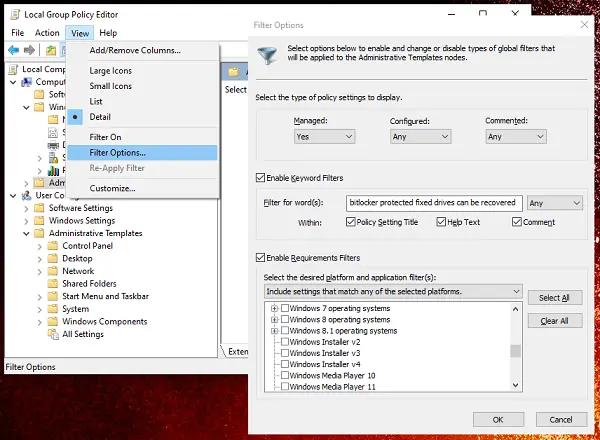How to search Group Policy
The Group Policy Editor allows you to change policies that can restrict, enable, or disable features in Windows. There are thousands of policies, and if you do not know how to search, it is almost impossible to find anything. There are multiple ways to find for a Grop Policy Object. You can follow any of these methods: You can use any of these methods, but our recommendation stays with the first one as it is more updated and reliable.
1] Search using Group Policy Filter
If you think, why are we even talking about it? The thing is that unlike Registry Editor, which offers direct search, there is no search in Group Policy Editor. You cannot press Ctrl + F and start typing and search what you were looking for. Instead, Group Policy offers Filters.
Open Group Policy Editor using gpedit.msc in the Run prompt.The Filter is available only for Administrative Templates under User configuration and Computer configuration.Select it, and then click on View > Filter Options.It will open a Filter window which has a ton of options.Type of policy settings: Managed, Configured, and Commented.Check the box which says Enable Keyword FiltersThe last filter is Requirements filter, which is useful if you are looking for a policy that is for a particular platform, i.e. Windows 10, etc.Click OK, and then click on the Filter iconClick on All Settings, and you will have a better view of the policies.
Anytime you want to disable the Filter, click on the icon again, and it will display all the policies. The implementation of using Filter is better than search. The implementation is such that the filter keeps the last keyword you had used, which makes it user-friendly.
2] Search Group Policy Online
Group Policy Search is an official and online tool from Microsoft, which lets you search Microsoft Active Directory Group Policy Settings. Once you are on the website, you can either use the search box or filter method to find the policy. The advantage of using this tool is it is more comfortable than the inbuilt tool. Once you have the full path, you can directly navigate in the Group Policy Editor and make the changes. It is also useful when you do not have access to GPE, and you want to know what a certain policy is useful, and on which OS it is supported.
3] NIT-GPOSearch Tool
It’s a free tool that comes with a huge advantage. It can also display the registry keys for a policy. Every Group Policy has a registry entry, and it is incredibly useful for those who need to know both the policy and its registry entry. Once you install the software, launch it from the application menu. It will offer a search box where you can type the policy description. It will look for the policy name in C:\Windows\Policy Definitions. All the policies are saved in this folder in admx, adml format. As you mouse hover on each of them, a preview will give you more detail about the policy. Overall its an excellent solution, but be warned that it gets slow during the search, so give it a bit of time. Read: Group Policy Settings Reference Spreadsheet & ADMX Templates for Windows 11.
4] Offline Group Policy Sheet
Lastly, there is an entirely offline way to search for Group Policy. But we don’t think it’s reliable as you will need to keep it updated. Microsoft offers a Group Policy Settings Reference for Windows and Windows Server. You can download the Excel sheet and use it. We hope now you will be able to search for GPOs much faster than ever before.

